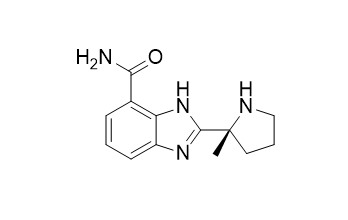Veliparib (ABT-888)
Veliparib (ABT-888, NSC 737664) is a potent inhibitor of PARP1 and PARP2 with Ki of 5.2 nM and 2.9 nM in cell-free assays, respectively. It is inactive to SIRT2. Veliparib increases autophagy and apoptosis.
Inquire / Order:
manager@chemfaces.com
Technical Inquiries:
service@chemfaces.com
Tel:
+86-27-84237783
Fax:
+86-27-84254680
Address:
1 Building, No. 83, CheCheng Rd., Wuhan Economic and Technological Development Zone, Wuhan, Hubei 430056, PRC
Providing storage is as stated on the product vial and the vial is kept tightly sealed, the product can be stored for up to
24 months(2-8C).
Wherever possible, you should prepare and use solutions on the same day. However, if you need to make up stock solutions in advance, we recommend that you store the solution as aliquots in tightly sealed vials at -20C. Generally, these will be useable for up to two weeks. Before use, and prior to opening the vial we recommend that you allow your product to equilibrate to room temperature for at least 1 hour.
Need more advice on solubility, usage and handling? Please email to: service@chemfaces.com
The packaging of the product may have turned upside down during transportation, resulting in the natural compounds adhering to the neck or cap of the vial. take the vial out of its packaging and gently shake to let the compounds fall to the bottom of the vial. for liquid products, centrifuge at 200-500 RPM to gather the liquid at the bottom of the vial. try to avoid loss or contamination during handling.
Mal J Med Health Sci.2024, 20(SUPP5):151-156.
Food Funct.2022, 13(13):6923-6933.
Appl. Sci.2021, 11(24),12080
Nutr Res Pract.2023, 17(4):670-681.
Antioxidants (Basel).2021, 10(3):379.
Anal Bioanal Chem.2018, 410(5):1561-1569
Nat Commun.2024, 15(1):8221.
Phytomedicine.2019, 59:152785
J Ginseng Res.2023, 47(4):572-582.
Planta Med.2018, 84(6-07):465-474
Related and Featured Products
J Med Chem,2009 Jan 22;52(2):514-23.
Discovery of the Poly(ADP-ribose) polymerase (PARP) inhibitor 2-[(R)-2-methylpyrrolidin-2-yl]-1H-benzimidazole-4-carboxamide (ABT-888) for the treatment of cancer.[Pubmed:
19143569]
We have developed a series of cyclic amine-containing benzimidazole carboxamide PARP inhibitors with a methyl-substituted quaternary center at the point of attachment to the benzimidazole ring system.
METHODS AND RESULTS:
These compounds exhibit excellent PARP enzyme potency as well as single-digit nanomolar cellular potency. These efforts led to the identification of 3a (2-[(R)-2-methylpyrrolidin-2-yl]-1H-benzimidazole-4-carboxamide, ABT-888), currently in human phase I clinical trials. Compound 3a displayed excellent potency against both the PARP-1 and PARP-2 enzymes with a K(i) of 5 nM and in a C41 whole cell assay with an EC(50) of 2 nM. In addition, 3a is aqueous soluble, orally bioavailable across multiple species, and demonstrated good in vivo efficacy in a B16F10 subcutaneous murine melanoma model in combination with temozolomide (TMZ) and in an MX-1 breast cancer xenograft model in combination with either carboplatin or cyclophosphamide.
Clin Cancer Res, 2007 May 15;13(10):3033-42.
Inhibition of poly(ADP-ribose) polymerase enhances cell death and improves tumor growth delay in irradiated lung cancer models.[Pubmed:
17505006]
Poly(ADP-ribose) polymerase-1 (PARP-1) is the founding member of a family of enzymes that catalyze the addition of ADP-ribose units to proteins that mediate DNA repair pathways. Ionizing radiation induces DNA strand breaks, suggesting that PARP-1 inhibition may sensitize tumor cells to radiation.
METHODS AND RESULTS:
We investigated the combination of PARP-1 inhibition with radiation in lung cancer models. ABT-888, a novel potent PARP-1 inhibitor, was used to explore the effects of PARP-1 inhibition on irradiated tumors and tumor vasculature.ABT-888 reduced clonogenic survival in H460 lung cancer cells, and inhibited DNA repair as shown by enhanced expression of DNA strand break marker histone gamma-H2AX. Both apoptosis and autophagy contributed to the mechanism of increased cell death. Additionally, ABT-888 increased tumor growth delay at well-tolerated doses in murine models. For a 5-fold increase in tumor volume, tumor growth delay was 1 day for ABT-888 alone, 7 days for radiation alone, and 13.5 days for combination treatment. Immunohistochemical staining of tumor sections revealed an increase in terminal deoxyribonucleotide transferase-mediated nick-end labeling apoptotic staining, and a decrease in Ki-67 proliferative staining after combination treatment. Matrigel assay showed a decrease in in vitro endothelial tubule formation with ABT-888/radiation combination treatment, and von Willebrand factor staining of tumor sections revealed decreased vessel formation in vivo, suggesting that this strategy may also target tumor angiogenesis.
CONCLUSIONS:
We conclude that PARP-1 inhibition shows promise as an effective means of enhancing tumor sensitivity to radiation, and future clinical studies are needed to determine the potential of ABT-888 as a radiation enhancer.
Clin Cancer Res,2007 May 1;13(9):2728-37.
ABT-888, an orally active poly(ADP-ribose) polymerase inhibitor that potentiates DNA-damaging agents in preclinical tumor models.[Pubmed:
17473206]
Animal Models: NCI-H460, H460, B16F10 and 9L xenografts in C57BL/6 mice
Dosages:~25 mg/kg
Administration: Orally administered



